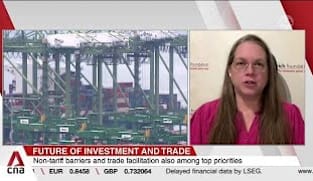Chee Hong Tat on National Productivity Fund (Amendment) Bill
Money from the National Productivity Fund (NPF) can be used to anchor quality investments in Singapore and cover investment promotion activities. Senior Minister of State for Finance Chee Hong Tat, who highlighted the proposed changes in a Bill in Parliament on Thursday (Aug 3), said investment promotion has been a cornerstone of Singapore's economic growth. As the external environment becomes more challenging and competition for investments increases, Singapore is also having less scope to use tax incentives as a tool to attract new investments. At the same time, countries are stepping up efforts to attract new investments, particularly in strategic sectors such as semiconductors and biomedical manufacturing. “We will not be able to, nor should we try to outbid these major economies in terms of spending,” he said. He stressed the need to ensure that Singapore remains “top of mind as a choice destination for investments and talent”. To demonstrate this commitment, Deputy Prime Minister and Finance Minister Lawrence Wong announced in his Budget statement that the Government will top up the NPF with S$4 billion and expand its scope to include investment promotion as a supportable activity. The Bill will effect the changes announced earlier this year and allow the NPF to be used to anchor quality investments from multinational enterprises (MNEs) in Singapore. These include incentives to attract companies and advanced industries to make new manufacturing investments here. It can also support efforts by MNEs to train and upskill local workers. “We are setting aside funds when we can to ensure that we have the resources ready to anchor new investments when there are opportunities to do so. This is crucial because MNEs make their investment decisions based on business and investment cycles, which may not align neatly with funding mechanisms bound by the terms of Government,” said Mr Chee. “This is how we ensure that each new investment we bring in strengthens the vibrancy of our economy, enhances our competitiveness and ultimately benefits Singapore and Singaporeans,” he said. Mr Chee said Singapore will continue to tap on the NPF to support local enterprises to improve productivity and generate greater value. These include the Construction Productivity and Capability Fund (CPCF), which offers incentives to help firms adopt productive technology and develop their workforce to raise productivity. To date, the CPCF has helped more than 10,000 companies; more than 90 per cent are small- and medium-sized enterprises. The NPF also supports initiatives such as the SkillsFuture Work-Study programme. It has helped more than 7,000 graduates of the Institutes of Technical Education and polytechnics.
Money from the National Productivity Fund (NPF) can be used to anchor quality investments in Singapore and cover investment promotion activities. Senior Minister of State for Finance Chee Hong Tat, who highlighted the proposed changes in a Bill in Parliament on Thursday (Aug 3), said investment promotion has been a cornerstone of Singapore's economic growth. As the external environment becomes more challenging and competition for investments increases, Singapore is also having less scope to use tax incentives as a tool to attract new investments. At the same time, countries are stepping up efforts to attract new investments, particularly in strategic sectors such as semiconductors and biomedical manufacturing. “We will not be able to, nor should we try to outbid these major economies in terms of spending,” he said. He stressed the need to ensure that Singapore remains “top of mind as a choice destination for investments and talent”. To demonstrate this commitment, Deputy Prime Minister and Finance Minister Lawrence Wong announced in his Budget statement that the Government will top up the NPF with S$4 billion and expand its scope to include investment promotion as a supportable activity. The Bill will effect the changes announced earlier this year and allow the NPF to be used to anchor quality investments from multinational enterprises (MNEs) in Singapore. These include incentives to attract companies and advanced industries to make new manufacturing investments here. It can also support efforts by MNEs to train and upskill local workers. “We are setting aside funds when we can to ensure that we have the resources ready to anchor new investments when there are opportunities to do so. This is crucial because MNEs make their investment decisions based on business and investment cycles, which may not align neatly with funding mechanisms bound by the terms of Government,” said Mr Chee. “This is how we ensure that each new investment we bring in strengthens the vibrancy of our economy, enhances our competitiveness and ultimately benefits Singapore and Singaporeans,” he said. Mr Chee said Singapore will continue to tap on the NPF to support local enterprises to improve productivity and generate greater value. These include the Construction Productivity and Capability Fund (CPCF), which offers incentives to help firms adopt productive technology and develop their workforce to raise productivity. To date, the CPCF has helped more than 10,000 companies; more than 90 per cent are small- and medium-sized enterprises. The NPF also supports initiatives such as the SkillsFuture Work-Study programme. It has helped more than 7,000 graduates of the Institutes of Technical Education and polytechnics.



















